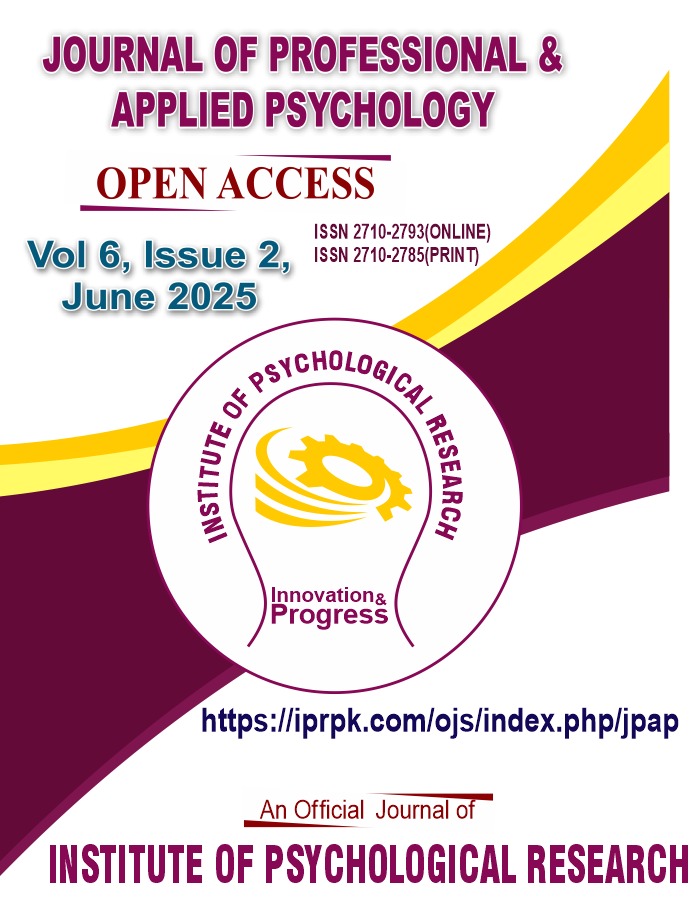Imposter Phenomenon and Burnout in University Students: Moderating Role of Coping Strategies
DOI:
https://doi.org/10.52053/jpap.v6i2.362Keywords:
Burnout, Coping Strategies, Imposter Phenomenon, Mental Health, StudentsAbstract
Imposter phenomenon (IP) is the fear of being exposed as a fraud or an imposter. Recent studies have examined the rise of IP in students. Hence, this study was focused on the detrimental effects of IP on students’ mental health. It examined the relationship between IP, and burnout (along with its 2 subscales; i.e., exhaustion and disengagement) of university students, along with the moderating effect of coping strategies. It was hypothesized that there is correlation among IP, coping strategies and burnout. Further, IP is likely to predict burnout. Moderating effect of coping strategies on the relationship of IP and burnout was also hypothesized. Lastly, gender differences were hypothesized among IP, coping strategies and burnout. Non-probability snowball sampling was used to recruit samples of N = 160 university students. Clance Imposter Phenomenon scale (Clance & Imes, 1978), Oldenburg Burnout Inventory (Baker & Demerouti, 2008) and Coping Scale (Hamby et al., 2015) were used. Pearson-product moment correlational analysis, multiple hierarchical regression and independent sample t-test were used to evaluate results, which showed positive correlation among IP, exhaustion, and disengagement. IP was also a significant predictor of exhaustion and disengagement (i.e., burnout). No moderating effect of coping strategies was found. Only IP, exhaustion and coping strategies had gender differences. Hence, all hypotheses were justified except one. The findings will give a better understanding of students’ mental health and will be helpful in designing coaching programs that will help them alleviate frequent imposter feelings, managing burnout associated with it and enhancing coping strategies.
References
Alayya, S., Dar, U., Always, M., Alghutayghit, A., & Alrayyes, N. (2020). Burnout and imposter syndrome among Saudi young adults. The strings in the puppet show of psychological morbidity. Saudi Medical Journal, 41(2), 189–194. https://doi.org/10.15537/smj.2020.2.24841
Bakker, A., & Demerouti, E. (2008). The Oldenburg Burnout Inventory: A good alternative to measure burnout and engagement. The Handbook of Stress and Burnout in Health Care, 65–78. https://www.academia.edu/2796247/The_Oldenburg_Burnout_Inventory_A_good_alternative_to_measure_burnout_and_engagement
Barr-Walker, J., Werner, D. A., Kellermeyer, L., & Bass, M. B. (2020). Coping with Impostor Feelings: Evidence Based Recommendations from a Mixed Methods Study. Evidence Based Library and Information Practice, 15(2), 24–41. https://doi.org/10.18438/eblip29706
Bravata, D. M., Watts, S. A., Keefer, A. L., Madhusudhan, D. K., Taylor, K. T., Clark, D. M., Nelson, R. S., Cokley, K. O., & Hagg, H. K. (2019). Prevalence, Predictors, and Treatment of Impostor Syndrome: a Systematic Review. Journal of General Internal Medicine, 35(4), 1252–1275. https://doi.org/10.1007/s11606-019-05364-1
Canning, E. A., LaCosse, J., Kroeper, K. M., & Murphy, M. C. (2019). Feeling like an imposter: the effect of perceived classroom competition on the daily psychological experiences of First-Generation college students. Social Psychological and Personality Science, 11(5), 647–657. https://doi.org/10.1177/1948550619882032
Capri, B., Ozkendir, O. M., Ozkurt, B., & Karakus, F. (2012). General Self-Efficacy beliefs, Life Satisfaction and Burnout of University Students. Procedia - Social and Behavioral Sciences, 47, 968–973. https://doi.org/10.1016/j.sbspro.2012.06.765
Chowdhury, R. B. M. A. (2020, September 1). What is Coping Theory? PositivePsychology.Com.
Clance, P. R., & Imes, S. A. (1978). The imposter phenomenon in high achieving women: Dynamics and therapeutic intervention. Psychotherapy: Theory, Research & Practice, 15(3), 241–247. https://doi.org/10.1037/h0086006
Cohen, E. D., & McConnell, W. R. (2019). Fear of fraudulence: graduate school program environments and the impostor phenomenon. Sociological Quarterly, 60(3), 457–478. https://doi.org/10.1080/00380253.2019.1580552
Cokley, K., Stone, S., Krueger, N., Bailey, M., Garba, R., & Hurst, A. (2018). Self-esteem as a mediator of the link between perfectionism and the impostor phenomenon. Personality and Individual Differences, 135, 292–297. https://doi.org/10.1016/j.paid.2018.07.032
Fassl, F., Yanagida, T., & Kollmayer, M. (2020). Impostors dare to compare: associations between the impostor phenomenon, gender typing, and social comparison orientation in university students. Frontiers in Psychology, 11. https://doi.org/10.3389/fpsyg.2020.01225
Franklin, P. M. (2014). Psychological Aspects of Kidney Transplantation and Organ Donation. Kidney Transplantation–Principles and Practice, 698–714. https://doi.org/10.1016/b978-1-4557-4096-3.00040-4
Gam, J., Kim, G., & Jeon, Y. (2016). Influences of art therapists’ self-efficacy and stress coping strategies on burnout. The Arts in Psychotherapy, 47, 1–8. https://doi.org/10.1016/j.aip.2015.09.005
García, G. M., Desrumaux, P., Calvo, J. C. A., & Naouële, B. (2021). The impact of social support on emotional exhaustion and workplace bullying in social workers. European Journal of Social Work, 25(5), 752–765. https://doi.org/10.1080/13691457.2021.1934417
Garmendia, P., Fernández-Salinero, S., González, A. I. H., & Topa, G. (2023). Social support and its impact on job satisfaction and emotional exhaustion. European Journal of Investigation in Health Psychology and Education, 13(12), 2827–2840. https://doi.org/10.3390/ejihpe13120195
Goncalo, J. A., & Kandathil, G. M. (2007). Connecting Group success to Individual Achievement: Cross-Cultural Attribution for Group Performance. Academy of Management Proceedings, 2007(1), 1–6. https://doi.org/10.5465/ambpp.2007.26508234
Gorsi, H., Ali, S. A., & Tariq, S. (2023). A conceptual model of impostor phenomenon and job performance: role of vicarious learning, impression management, and Self-Reflection. Journal of Professional & Applied Psychology, 4(3), 460–477. https://doi.org/10.52053/jpap.v4i3.183
Hamby, S., Grych, J., & Banyard, V. (2015). Coping Scale. 10.13140/RG.2.1.3094.0001.
Han, J. Y., Lee, H., Ohtsubo, Y., & Masuda, T. (2022). Culture and stress coping: cultural variations in the endorsement of primary and secondary control coping for daily stress across European Canadians, East Asian Canadians, and the Japanese. Japanese Psychological Research, 64(2), 141–155. https://doi.org/10.1111/jpr.12406
Hutchins, H. M., & Rainbolt, H. (2016). What triggers imposter phenomenon among academic faculty? A critical incident study exploring antecedents, coping, and development opportunities. Human Resource Development International, 20(3), 194–214. https://doi.org/10.1080/13678868.2016.1248205
Institute for Quality and Efficiency in Health Care (IQWiG). (2020, June 18). Depression: Learn More – What is burnout? InformedHealth.org - NCBI Bookshelf. https://www.ncbi.nlm.nih.gov/books/NBK279286/
Jarrett, C. (2018, June 1). A new study claims that, under pressure, imposter syndrome hits men harder than women. British Psychological Society Research Digest. https://www.bps.org.uk/research-digest/new-study-claims-under-pressure-imposter-syndrome-hits-men-harder-women
Kiani, K. (2011, October 26). 35% of population comes under middle class: study. The Express Tribune. https://tribune.com.pk/story/282801/35-of-population-comes-under-middle-class
Kolligian Jr., J., & Sternberg, R. J. (1991). Perceived Fraudulence in Young Adults: Is There an “Imposter Syndrome”? Journal of Personality Assessment, 56(2), 308–326. https://doi.org/10.1207/s15327752jpa5602_10
Kuo, B. C. H. (2012). Collectivism and coping: Current theories, evidence, and measurements of collective coping. International Journal of Psychology, 48(3), 374–388. https://doi.org/10.1080/00207594.2011.640681
Leach, P. K., Nygaard, R. M., Chipman, J. G., Brunsvold, M. E., & Marek, A. P. (2019). Impostor Phenomenon and Burnout in General Surgeons and General Surgery Residents. Journal of Surgical Education, 76(1), 99–106. https://doi.org/10.1016/j.jsurg.2018.06.025s
Leicht, C., Goclowska, M. A., Van Breen, J. A., De Lemus, S., & De Moura, G. R. (2017). Counter Stereotypes and feminism promote leadership aspirations in highly identified women. Frontiers in Psychology, 8. https://doi.org/10.3389/fpsyg.2017.00883
Levant, B., Villwock, J. A., & Manzardo, A. M. (2020). Impostorism in American medical students during early clinical training: gender differences and intercorrelating factors. International Journal of Medical Education, 11, 90–96. https://doi.org/10.5116/ijme.5e99.7aa2
Noureen, A., Shah, A. A., & Shah, M. A. (2019). The Moderating Role of Coping Strategies in Occupational Stress and Burnout among Mental Health Practitioners in Pakistan. Clinical and Counselling Psychology Review, 1(1), 28–43. https://doi.org/10.32350/ccpr.11.03
Rogala, A., Shoji, K., Luszczynska, A., Kuna, A., Yeager, C., Benight, C. C., & Rohrmann, S., Bechtoldt, M. N., & Leonhardt, M. (2016). Validation of the Impostor Phenomenon among Managers. Frontiers in Psychology, 7. https://doi.org/10.3389/fpsyg.2016.00821
Rosales-Ricardo, Y., Rizzo-Chunga, F., Mocha-Bonilla, J., & Ferreira, J. P. (2021). Prevalence of burnout syndrome in university students: A systematic review. Salud Mental, 44(2), 91–102. https://doi.org/10.17711/sm.0185-3325.2021.013
Rossi, A. M., Meurs, J. A., & Perrewé, P. L. (2013). Improving Employee Health and Well Being (Stress and Quality of Working Life). Information Age Publishing.
Saleem, I., Almadi, S., & Saleem, A. (2013). Do Pakistani parents’ still dominate career choice of generation next? SSRN Electronic Journal. https://autopapers.ssrn.com/sol3/papers.cfm?abstract_id=2603845
Schubert, N., & Bowker, A. (2019). Examining the impostor phenomenon in relation to Self-Esteem level and Self-Esteem instability. Current Psychology, 38(3), 749–755. https://doi.org/10.1007/s12144-017-9650-4
Schuster, B., Forsterlung, F., & Weiner, B. (1989). Perceiving the causes of success and failure. Journal of Cross-Cultural Psychology, 20(2), 191–213. https://doi.org/10.1177/0022022189202005
Shin, H., Park, Y. M., Ying, J. Y., Kim, B., Noh, H., & Lee, S. M. (2014). Relationships between coping strategies and burnout symptoms: A meta-analytic approach. Professional Psychology Research and Practice, 45(1), 44–56. https://doi.org/10.1037/a0035220
TheGlobalEconomy.com. (2023). Pakistan: Labor force. TheGlobalEconomy.com. https://www.theglobaleconomy.com/pakistan/labor_force/
The Qur'an (M. A. S. Abdel Haleem, Trans.). (2008). Oxford University Press.
Villwock, J. A., Sobin, L. B., Koester, L. A., & Harris, T. M. (2016). Impostor syndrome and burnout among American medical students: a pilot study. International Journal of Medical Education, 7, 364–369. https://doi.org/10.5116/ijme.5801.eac4
Wang, K. T., Sheveleva, M. S., & Permyakova, T. M. (2019). Imposter syndrome among Russian students: The link between perfectionism and psychological distress. Personality and Individual Differences, 143, 1–6. https://doi.org/10.1016/j.paid.2019.02.005
Yusuf, F. (2023, November 6). Whose career choice is it – students’ or parents’? Times Higher Education. https://www.timeshighereducation.com/counsellor/managing-stakeholders/whose-career-choice-it-students-or-parents
Zahid, N. R., Fiaz, N. M., & Taus, N. M. (2024). The Dark Side of Success: Impostor phenomenon as a predictor of Self-Sabotaging Behavior and Workaholism. Open Access Organization and Management Review, 3(1), 8–18. https://doi.org/10.59644/oagmr.3(1).108
Downloads
Published
How to Cite
Issue
Section
Categories
License
Copyright (c) 2025 Momina Yahya, Shazia Qayyum, Salma Rasheed

This work is licensed under a Creative Commons Attribution-NonCommercial 4.0 International License.
Creative Commons Attribution-Non Commercial 4.0 International (CC BY-NC 4.0) License: This article is distributed under the terms of the Creative Commons Attribution-Non Commercial 4.0 International License (https://www.creativecommons.org/licenses/by-nc/4.0/) which permits non-Commercial use, reproduction and distribution of the work without further permission provided the original work is attributed as specified on the Journal website at (https://iprpk.com/ojs/index.php/jpap)












